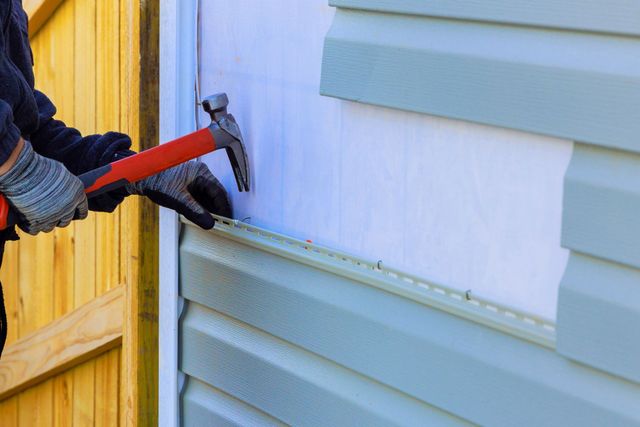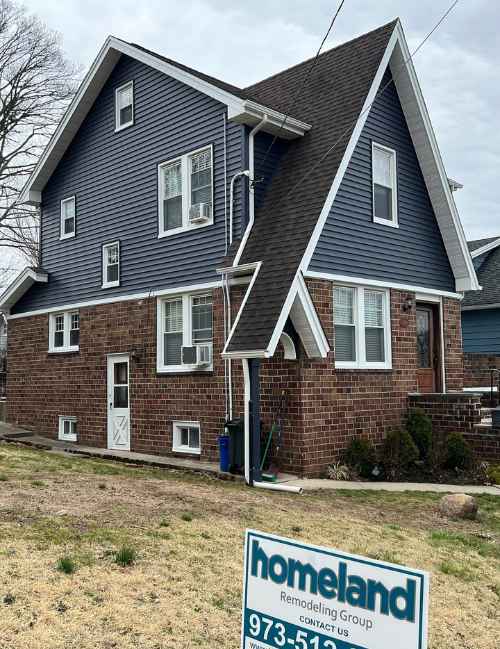The Essential Overview to the Various Kinds of House Siding and Their Distinct Benefits
In the realm of home renovation, selecting the appropriate home siding is an important choice that impacts both aesthetic appeal and functional efficiency. The range of products offered, such as timber, vinyl, fiber cement, metal, and brick, each offer special advantages that deal with different demands and preferences. Understanding these differences can dramatically boost the durability and value of a home - morris siding contractor. With so several alternatives to consider, which siding product really stands out for your particular task? Discovering these options can result in educated decisions that align with both design and practicality.
Timber House Siding
Wood house siding, a preferred option for residential exteriors, supplies a timeless aesthetic that incorporates all-natural elegance with architectural honesty. This exterior siding product is offered in various styles, consisting of clapboard, tiles, and board-and-batten, allowing homeowners to personalize their appearance to match their style choices. Timber house siding is commonly crafted from resilient varieties such as cedar, redwood, or want, which are recognized for their resilience and capacity to stand up to ecological stress factors.
One of the key advantages of timber house siding is its excellent insulation properties, which can add to power performance and lower home heating costs. Furthermore, timber siding is naturally degradable, making it an eco friendly option when sourced sustainably. Routine upkeep, including paint or staining, can extend its life expectancy and boost its look, permitting house owners to preserve the natural charm of the wood.
Nonetheless, potential disadvantages consist of susceptibility to pests, rot, and weather damage, requiring adequate treatment and maintenance - morris siding contractor. In spite of these problems, when effectively taken care of, wood siding can offer a sturdy and attractive solution that enhances the personality of a home while using a cozy, inviting ambience

Plastic Siding
Vinyl siding has actually become a leading choice for home owners seeking a low-maintenance exterior choice that incorporates resilience and affordability. This functional product is crafted from polyvinyl chloride (PVC), making it resistant to different climate condition, consisting of dampness and UV rays. As a result, plastic siding does not warp, rot, or discolor, making certain resilient visual charm.
Among the key advantages of vinyl siding is its comprehensive variety of shades and designs, enabling house owners to attain the desired try to find their residential property without the need for regular repainting. Additionally, plastic house siding is very easy to set up, which can considerably reduce labor costs during building and construction or restoration projects.
Vinyl house siding additionally adds to power performance. Several choices attribute insulation support, which improves thermal performance, helping to preserve comfy interior temperatures and potentially lowering power bills. Moreover, its smooth surface area facilitates easy cleansing, needing only periodic cleaning with a yard hose pipe to get rid of dirt and debris.
Fiber Cement Siding
Fiber concrete home siding has actually gotten traction among homeowners and builders alike due to its amazing mix of toughness and visual adaptability. Composed of a mixture of cellulose, sand, and cement fibers, this siding alternative is crafted to endure severe climate condition, consisting of high winds, heavy rain, and temperature level More about the author variations, making it a long-lasting choice for residential outsides.

Among the main benefits of fiber concrete exterior siding is its resistance to parasites, such as termites, and its non-combustible nature, offering enhanced fire safety. morris siding contractor. Furthermore, it is readily available in a wide variety of structures, styles, and colors, allowing house owners to achieve their desired aesthetic without giving up performance
An additional benefit is its reduced upkeep requirements; fiber concrete home siding typically needs painting or staining every 5-10 years, which is less regular than other materials. Its longevity contributes to a reduced general price of ownership, as it lowers the requirement for constant repairs or substitutes.
Ultimately, fiber concrete exterior siding stands for a superb financial investment for those seeking a resistant, eye-catching, and flexible outside alternative, integrating both form and feature to improve the home's visual appeal.
Metal Siding
The attraction of metal home siding depends on its robust durability and contemporary aesthetic allure, making it a preferred selection for modern design. Available in materials such as light weight aluminum and steel, metal house siding provides a range of colors and surfaces, allowing property owners to accomplish a customized appearance that complements their layout vision.

Power performance is another considerable advantage, as numerous steel home siding products are created with insulation options that assist manage interior temperature levels. This can result in minimized energy expenses gradually. Furthermore, steel exterior siding is typically recyclable, making it an eco-friendly choice for sustainability-minded home owners.
The installation process for steel siding can be reasonably straightforward, leading to a quicker turnaround time for construction jobs. On the whole, steel exterior siding incorporates functionality and design, making it a useful choice for those seeking a enduring and aesthetically appealing exterior finish.
Block and Stone House Siding
Brick and rock exterior siding stands apart as a classic choice that enhances the aesthetic appeal of any home. Known for their durability and low upkeep, these materials provide an exceptional return on investment while boosting the building's visual appeal. link Offered in different shades, appearances, and patterns, block and stone can be tailored to match varied building styles, from traditional to contemporary.
One of the key advantages of block and stone home siding is their energy performance. Both materials possess all-natural insulating properties that assist manage interior temperature try here levels, possibly minimizing heating & cooling costs. Additionally, they use exceptional fire resistance contrasted to other house siding options, adding to improved safety.
Another benefit is their long life. Block and stone can last for decades, typically needing marginal maintenance beyond periodic cleaning. Unlike wood siding, they are invulnerable to insects and rot, making sure a lasting outside that holds up against the elements.
Verdict
In recap, the selection of exterior siding dramatically influences a home's visual appeal, power efficiency, and maintenance demands. Each kind of siding-- whether wood, plastic, fiber cement, brick, or steel and rock-- provides distinct benefits tailored to numerous home owner choices and ecological conditions. Understanding these options makes it possible for educated decisions that enhance both the resilience and visual appeal of residential outsides. Inevitably, selecting the right house siding is essential for attaining an equilibrium in between performance and style in property style.
One of the main advantages of wood house siding is its superb insulation buildings, which can add to energy effectiveness and reduced heating costs. Additionally, wood house siding is naturally degradable, making it an eco pleasant alternative when sourced sustainably.One of the main benefits of metal house siding is its resistance to numerous ecological variables.Power efficiency is an additional substantial advantage, as several steel house siding products are created with insulation choices that aid manage interior temperature levels. Each kind of siding-- whether timber, plastic, fiber concrete, brick, or metal and stone-- uses distinct benefits customized to various property owner preferences and ecological problems.